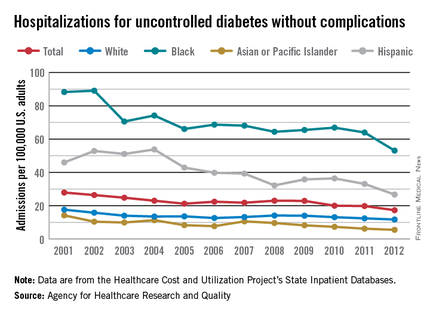The overall adult hospitalization rate for uncontrolled diabetes without complications dropped by 38% from 2001 to 2012, but considerable racial and ethnic disparities remained, according to the Agency for Healthcare Research and Quality (AHRQ).
That 38% represents a decrease from 27.9 per 100,000 U.S. adults in 2001 to 17.3 per 100,000 in 2012. The admission rate among blacks dropped by a slightly higher 40% over that period, but it started at a much-higher 88.3 per 100,000 adults before going down to 53.1 per 100,000 – still three times higher than the overall rate. The rate for Hispanics fell 42%, but it also was much higher than the overall rate to begin with: 46 per 100,000. The 2012 rate for Hispanic adults was 26.7 per 100,000, about 54% higher than the overall admission rate, the AHRQ reported.
Much closer to reaching the 2008 achievable benchmark of 5 admissions per 100,000 adults were Asians or Pacific Islanders, who went from a rate of 14.2 per 100,000 to 5.5 per 100,000, and whites, who went from 17.6 per 100,000 to 11.7 between 2001 and 2012, according to data from the AHRQ Healthcare Cost and Utilization Project’s State Inpatient Databases.
The report noted that, “at the current rate, the [2008 achievable] benchmark could not be met for the total population for approximately 17 years.” Asians or Pacific Islanders could meet that goal in 2 years, the AHRQ added, compared with 10 years for Hispanics, 20 years for blacks, and 22 years for whites.


